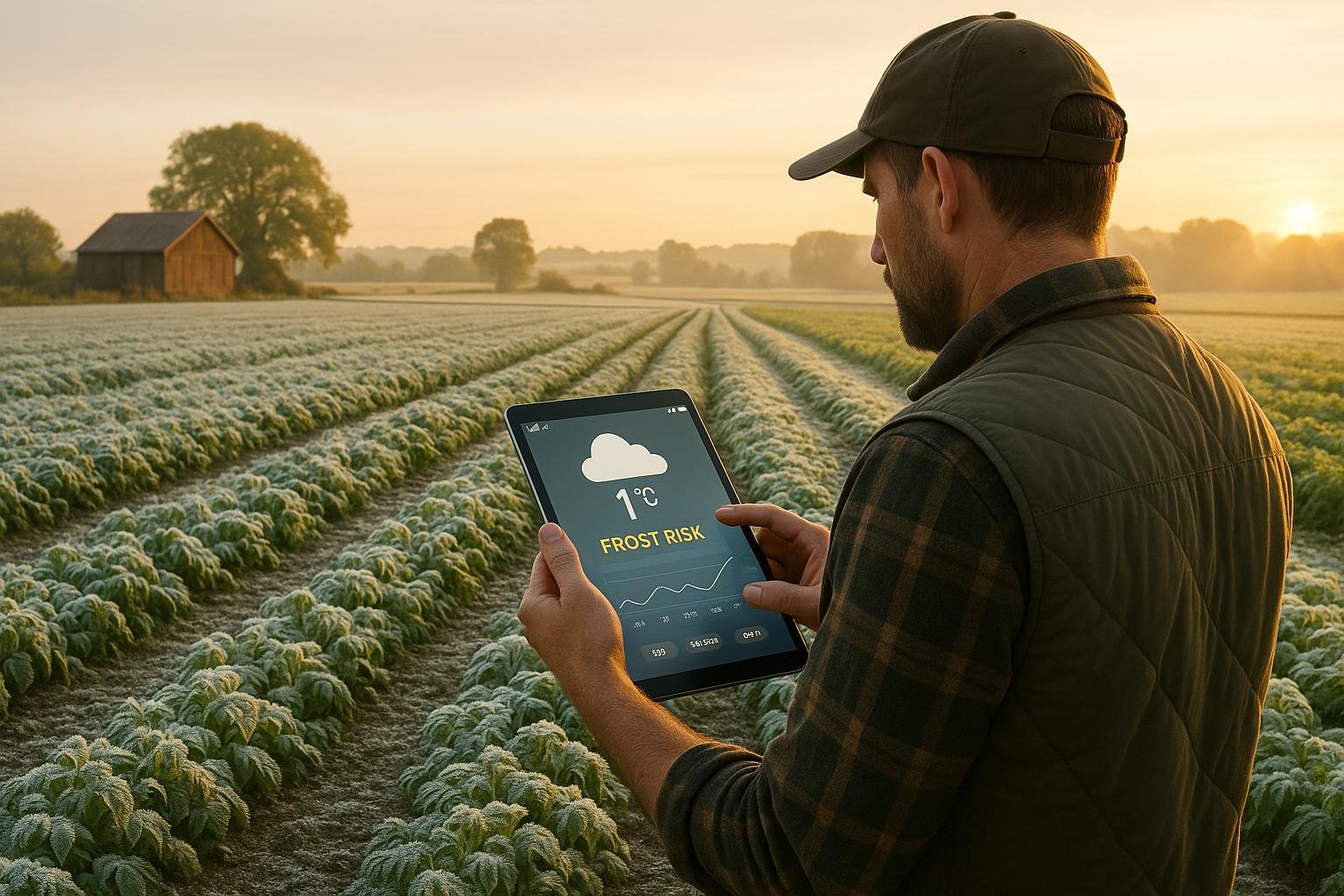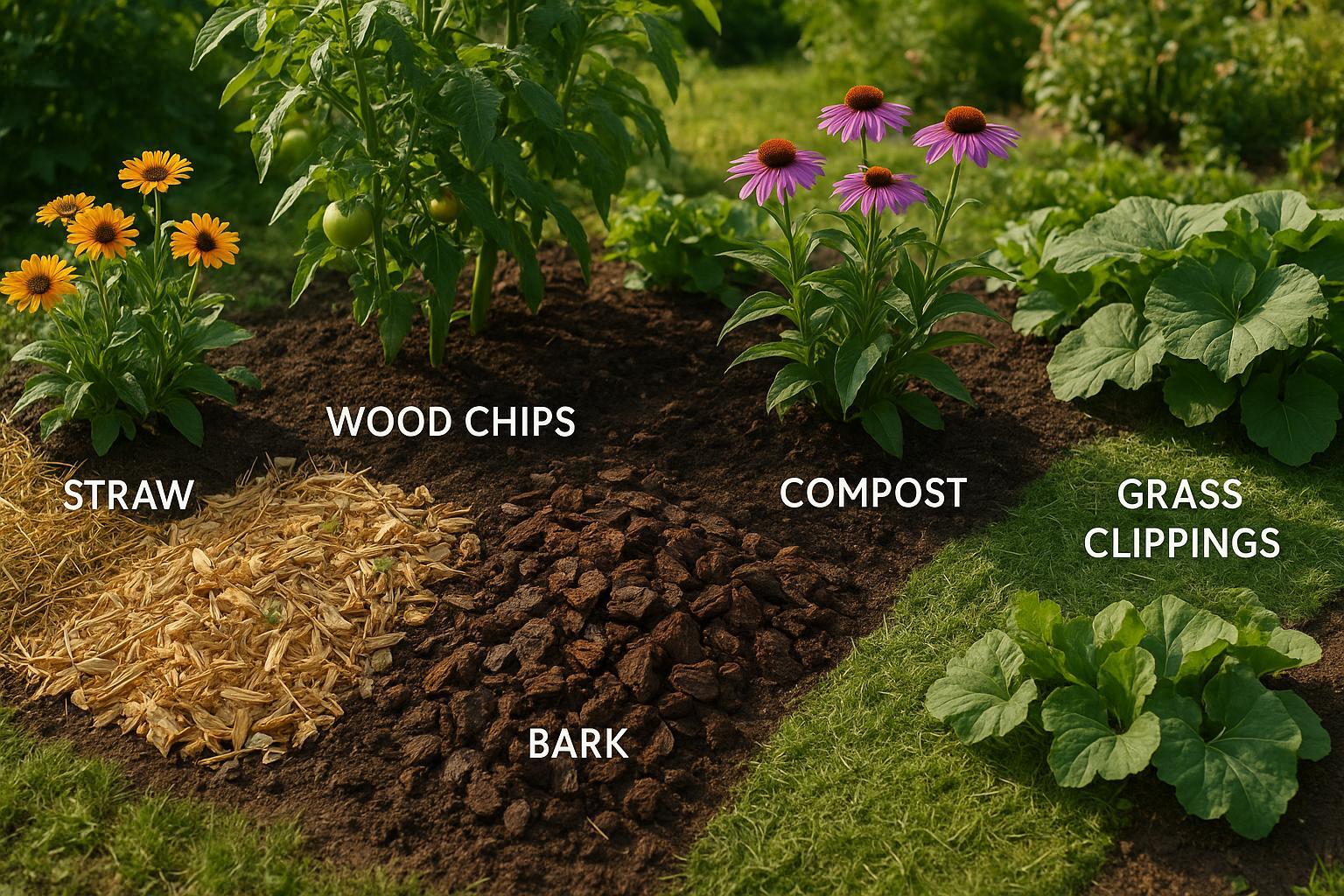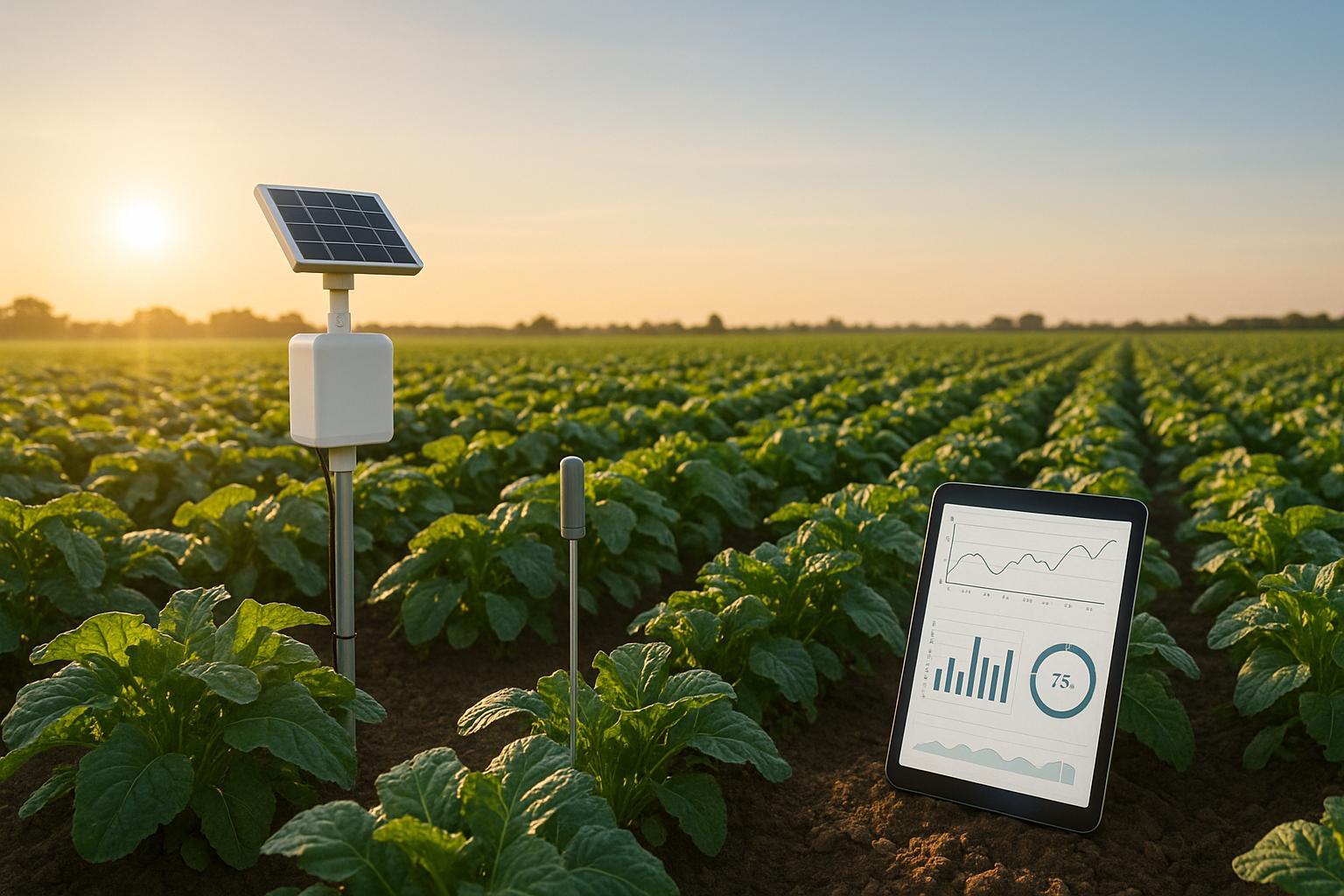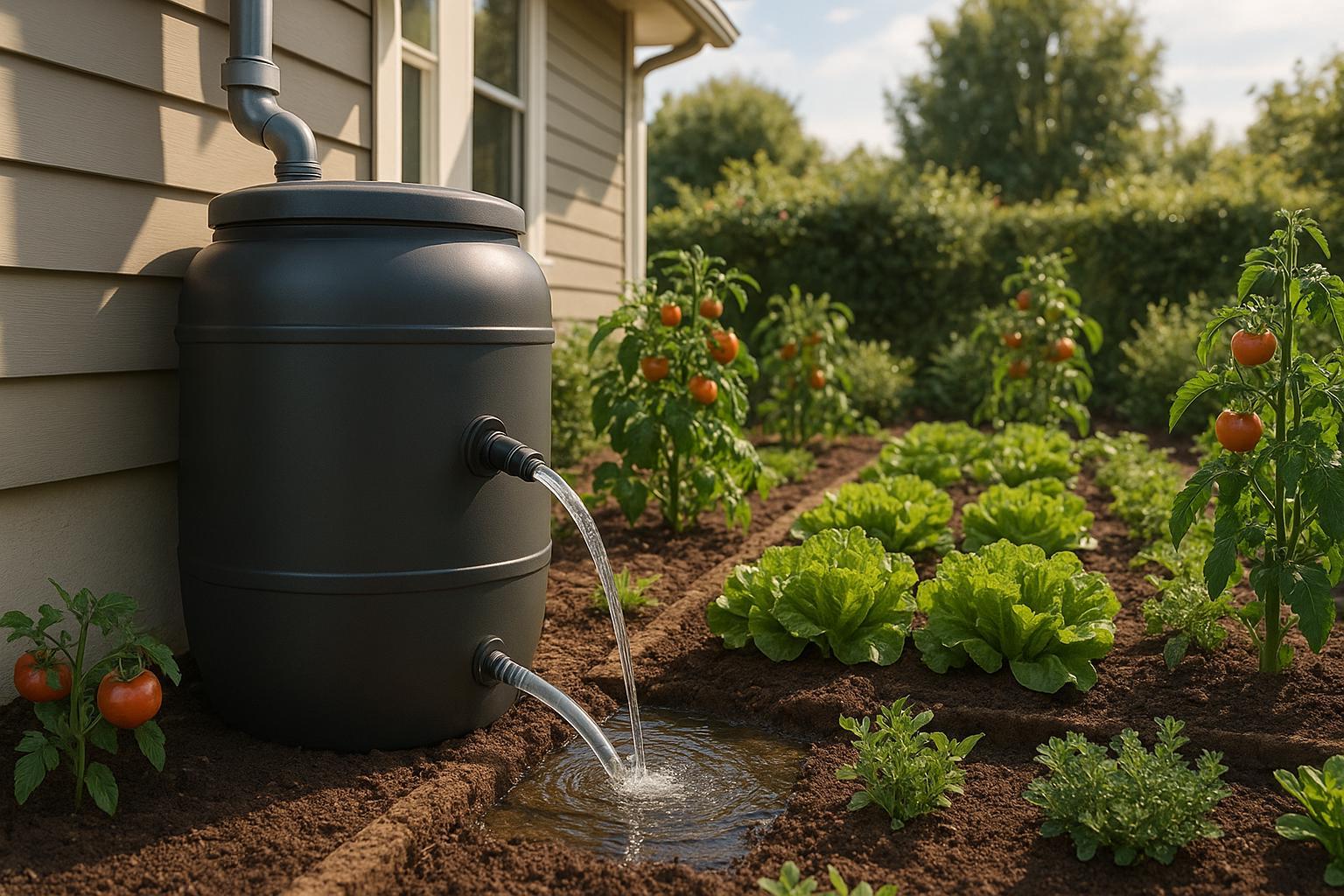How AI Predicts Frost Risks for Seasonal Planting

AI is transforming frost prediction for farmers and gardeners. By analyzing local weather data and historical patterns, AI tools provide precise, site-specific frost forecasts that outperform traditional methods. These systems help schedule planting, protect crops, and minimize frost-related losses.
Key Takeaways:
- AI tools like GraphCast deliver accurate 10-day forecasts in seconds.
- Frost prediction accuracy is improved, with errors reduced to 2.8–3.1°F for short-term forecasts.
- Farmers save money by using frost protection measures only when needed.
- AI models use data from IoT sensors, satellites, and local weather stations for hyper-local forecasts.
- USDA Plant Hardiness Zones guide planting schedules, but AI refines them based on real-time updates.
Why It Matters:
Frost damage has cost billions in crop losses, with single events causing up to $2.1 billion in damages. AI tools reduce these risks by providing actionable insights for smarter planting and crop protection.
Understanding Frost and Its Impact on Planting
What is Frost and Why Does It Matter?
Frost forms when water vapor condenses into ice on solid surfaces as temperatures drop to freezing levels [2]. You’ve likely seen this as icy crystals on car windshields or plants during cold mornings.
For gardeners and farmers, frost dates are essential for planning. These dates mark the boundaries of the growing season - when it’s safe to plant after the last spring frost and when the first fall frost signals it's time to harvest or protect crops [5][7][8]. Knowing these dates helps reduce the risk of frost damage, which can be costly for vulnerable plants.
Frost Damage to Plants
Frost damages plants by forming ice within their cells, which ruptures the cell walls. As Westwood explained in 1978, "It is not cold temperature but ice formation that actually injures the plants" [4]. This internal ice disrupts the plant’s structure, leading to visible damage.
The extent of frost damage depends on factors like the type of plant, the tissues exposed, and how low the temperature drops. A light frost - ranging from 28°F to 32°F - might only harm certain plants, while a hard frost below 28°F can destroy entire crops [2].
There are different types of frost, each with unique characteristics:
- White frost: Forms when humidity is high (over 90%) and temperatures fall below 18°F, leaving visible ice crystals.
- Black frost: Occurs in dry conditions without visible ice, often causing severe damage [2][3].
- Radiation frost: Develops on calm, clear nights when cold air settles in low-lying areas.
- Advection frost: Happens when cold air masses move in with wind [3].
These variations emphasize the importance of accurate frost predictions, especially as weather patterns grow more unpredictable.
The Role of Climate Zones
The USDA Plant Hardiness Zone system divides the United States into 13 zones based on average minimum temperatures, with each zone differing by 10°F. Zones are further split into “a” and “b” categories, separated by 5°F. For example, Zone 1a sees minimum temperatures around -60°F, while Zone 13b stays above 65°F [9].
Your zone influences typical frost dates and the length of your growing season. Here are some examples:
| Zone | Last Spring Frost | First Fall Frost | Growing Season |
|---|---|---|---|
| 4 | April 24 – May 12 | September 21 – October 7 | 140–170 days |
| 5 | April 7 – 30 | October 13 – 21 | 150–180 days |
| 6 | April 1 – 21 | October 17 – 31 | 160–200 days |
| 7 | March 22 – April 3 | October 29 – November 15 | 180–220 days |
| 8 | March 13 – 28 | November 7 – 28 | 200–240 days |
Microclimates - shaped by factors like elevation, nearby water, or terrain - can cause frost to arrive earlier or later than these averages [6].
Climate change adds another layer of complexity. Warmer conditions have caused plants to bud earlier, making them more vulnerable to unexpected late frosts [10]. This unpredictability highlights the need for precise, localized frost forecasts.
Plants have developed strategies to handle cold, either by avoiding damage or tolerating it. Avoidance methods include features like dense canopies or snow retention, while tolerance mechanisms involve lowering the freezing point or surviving extracellular ice formation [4]. Additionally, plants can “harden” over time, gradually building resistance to freezing as seasons transition [2].
These patterns underline why localized frost forecasts are so important for making informed planting decisions. By accounting for climate zones and microclimates, modern forecasting tools can help minimize frost-related risks.
How AI Predicts Frost Events
How AI Uses Data to Predict Frost
AI has reshaped frost prediction by analyzing extensive weather datasets through machine learning. These systems process an array of variables - temperature, solar radiation, humidity, soil temperature, precipitation, wind speed, and direction - to deliver precise frost forecasts [1].
What sets AI apart is its ability to create models tailored to specific locations using local data. Unlike broader numerical weather models, which often falter in areas with complex terrain, AI can pinpoint frost risks down to field and sub-field levels [1]. This level of precision is invaluable for farmers managing diverse landscapes.
Machine learning thrives on identifying complex patterns and less obvious frost scenarios, including extreme weather conditions that traditional forecasts might overlook [11]. As these models are exposed to new data, they continuously refine their predictions, adapting to different weather patterns and frost events over time.
"AI forecasting is only as good as the data that feeds it. That's why we've built our model on a top-tier open-source AI framework - but powered it with Spire's own satellite data." - Dr. Tom Gowan, Spire's Director of Weather Prediction and AI [11]
By prioritizing key factors - like soil temperature for predictions beyond 24 hours - AI ensures its forecasts remain both accurate and actionable [1]. This level of refinement translates directly into practical benefits for farmers, helping them protect their crops more effectively.
Benefits of AI-Driven Frost Prediction
AI-powered frost prediction offers clear advantages over traditional methods. For example, machine learning models have achieved a 6-hour prediction accuracy with a Root Mean Squared Error (RMSE) of just 1.53–1.72°C. In comparison, traditional 48-hour forecasts from the National Weather Service show a Mean Absolute Error (MAE) of 2.48–3.12°C [1].
This heightened accuracy means fewer crop losses and smarter resource management. Farmers can avoid unnecessary spending on frost protection when it’s not needed - a critical advantage for smaller farms operating on tight budgets [1].
The economic stakes are enormous. Frost events caused agricultural crop losses of $700 million in 1990, $2.1 billion in 2007, and $1.0 billion in 2017 in the United States alone [14]. AI predictions empower farmers to take timely action, reducing these financial blows through better preparation and planting strategies.
Modern AI systems also provide probabilistic forecasts rather than definitive outcomes. As Dr. Vela explains:
"Instead of saying 'this will happen,' we say: 'here are 30 ways it could play out, and here's how likely each scenario is.' That's the future of forecasting" [11]
This approach equips farmers with a broader range of scenarios, enabling them to make more informed decisions about frost protection and planting schedules.
Data Sources for AI Models
AI frost prediction models depend on diverse, high-quality data streams to ensure reliable forecasts. These systems combine 30-year weather averages that establish baseline climate patterns with real-time atmospheric data and advanced sensing technologies.
IoT sensors, automated weather stations, and satellite remote sensing work together to provide continuous, hyper-localized data. These tools track temperature, humidity, soil moisture, and even crop health [12] [13]. Automated weather stations (AWS) deliver real-time data specific to individual parcels of land, monitoring rainfall, solar radiation, wind conditions, and soil metrics [12].
Satellite remote sensing adds another layer of detail. It assesses crop health through vegetation indices (NDVI) and measures soil moisture across large areas [12]. For example, a study in Alcalde, New Mexico, demonstrated how machine learning models used these data sources to achieve 6-hour frost predictions with an RMSE of 1.72°C [1].
By integrating multiple data streams, AI models can generate hyper-localized forecasts that account for frost’s uneven impact within a single field. This detailed approach is crucial for protecting crops effectively [1].
"AI in agricultural weather prediction dramatically enhances forecast accuracy by learning over time and improving in line with new data and events." [12]
Importantly, these models are designed to operate with low computational demands, making them accessible even in areas with limited internet connectivity [1]. This ensures that small-scale farms can also benefit from advanced frost prediction technology. By combining various data layers, AI delivers actionable insights that help growers safeguard their crops with confidence.
Using AI Tools to Plan Seasonal Planting
Gathering Local Climate Data
Effective frost protection begins with a solid understanding of your local climate. AI-powered tools are particularly skilled at analyzing massive datasets to identify trends and predict extreme weather events, including frost that could damage crops [16]. These modern platforms process information from sensors, satellite images, and global climate models to provide insights into hyperlocal conditions - details that traditional forecasts often miss.
For instance, some AI tools take raw climate data and turn it into actionable insights using patented models. These models generate quick alerts and customizable dashboards, dynamically choosing the most accurate forecast for specific locations by analyzing historical performance and integrating fresh data points [15].
If you're a home gardener or landscaper, you can use these platforms by entering your USDA hardiness zone and specific location coordinates. The system then cross-references your data with long-term weather patterns, real-time atmospheric conditions, and satellite imagery to create a detailed climate profile tailored to your area.
Once you have this detailed profile, you can use AI tools to create planting schedules that align with your local conditions.
Using AI-Powered Platforms
With accurate climate data in hand, AI platforms take the guesswork out of planning. They simplify the process of creating frost-aware planting schedules. By providing details like your USDA hardiness zone, last frost date, and the plants you want to grow, these tools deliver personalized recommendations.
Take AIGardenPlanner, for example. This platform uses AI to transform garden photos into professional designs, offering over 50 garden styles to choose from. It provides plant suggestions based on your location, climate, and personal preferences. Detailed growing guides include frost risk considerations, helping you time your planting for the best results.
These platforms typically offer a wealth of information, such as plant names, ideal start dates, planting methods (indoor or direct sow), transplant timelines, germination periods, temperature needs (in both Celsius and Fahrenheit), and light requirements. The AI analyzes historical weather data, satellite images, and real-time sensor updates to provide hyperlocal and long-term forecasts [19]. Many planning tools also let you customize schedules with features like drag-and-drop functionality, alerting you if adjustments fall outside optimal growing conditions [17].
Adjusting Planting Plans Based on AI Insights
Once you've received AI-generated recommendations, it's time to fine-tune your planting strategy. While these platforms provide tailored schedules, understanding how to adapt them to your garden's specific needs is key [18].
Compare the AI's timeline with your local conditions. Predictive models, while detailed, might not account for every microclimate variation [20]. To manage frost risks, consider planting frost-hardy varieties early in the season. AI tools often include temperature tolerance ranges, helping you choose plants that can endure unexpected cold snaps. For more delicate plants, the AI might suggest starting seeds indoors and delaying transplanting until soil temperatures are consistently warm.
These algorithms also update in real-time, allowing you to adjust your planting schedule as weather conditions change. For example, if an extended cold spell is forecast, you can delay direct sowing or extend indoor growing periods [20].
Finally, don’t forget to provide feedback to the AI system. Share details like actual frost dates, soil temperatures, and plant performance. This helps improve the tool’s future recommendations, making your planting schedules even more precise over time [18].
🚀 Ready to Reinvent Your Garden?
Join thousands of homeowners who have transformed their gardens using our AI design tool. Upload one photo to explore endless possibilities.
Get your AI garden designs →🍃 Edge‑AI Weather That Helps Farms Thrive

sbb-itb-4d6a8dd
AI Strategies for Managing Frost Risks
Leveraging accurate frost predictions, AI plays a key role in shaping proactive strategies to mitigate frost-related risks.
Frost Protection Techniques
AI systems provide early frost alerts and suggest practical protective measures through continuous monitoring [14]. When frost warnings are issued, consider these steps:
- Use frost blankets or tarps to cover plants, ensuring they don’t touch the leaves, and secure them with weights to create an insulating air gap.
- Water the soil beforehand, as moist soil retains heat better than dry soil.
- Deploy string lights to offer gentle warmth around plants.
- Set up temporary wind barriers, such as wooden planks or cardboard, to block cold air [21].
These measures help shield plants from frost damage effectively.
Selecting Frost-Hardy Plants
AI-powered tools make it easier to choose plants that can endure sudden temperature drops. By analyzing the minimum temperatures each plant species can tolerate, these platforms provide tailored recommendations [22]. Instead of relying solely on general hardiness zones, AI tools use USDA cold hardiness ratings to suggest plants rated for climates one zone colder than your location [23]. They also consider specific microclimatic factors in your garden, offering a more precise approach to plant selection. This ensures that your garden is better prepared for unexpected frost events.
Monitoring Late-Season Temperature Changes
Late-season frosts can take gardeners by surprise, but AI tools excel at tracking local weather patterns. They provide timely alerts for temperature drops, heavy rainfall, and windstorms that may increase frost risks [25]. Setting up mobile notifications for hyperlocal updates allows you to adjust your gardening practices, such as watering, covering, or even relocating plants, in real time.
The financial impact of frost can be severe. For example, in 2017, late frost caused an estimated $77 million USD in damages to Austria’s viticulture and fruit-growing industries. Tietoevry, a technology company, helped farmers integrate climate data with weather forecasts to implement timely anti-frost measures. Franz G. Rosner, Research Coordinator for Sustainability and PR, highlighted the benefits:
"For the first time, the climate model offers the possibility to accurately record topographical differences in temperature and to set the right control measures. Every hour in which heating with candles or other frost control measures do not have to be taken saves farms a lot of money and protects the environment" [24].
To further enhance frost management, advanced gardeners are blending AI-driven alerts with IoT devices like soil sensors and automated irrigation systems. These technologies enable real-time monitoring and immediate responses to frost warnings, completing the loop of AI-powered frost risk management [26].
Regional Customization: Tailoring AI Recommendations to US Zones
Using localized frost data as a foundation, US-specific factors further refine planting strategies. The United States spans an incredible range of climates - from Alaska's icy winters to the tropical heat of southern Florida. AI-powered gardening platforms take these differences into account, customizing frost predictions and planting tips to suit each region.
Understanding Regional Frost Differences
The USDA Plant Hardiness Zone Map is key to understanding frost patterns across the US. This map divides the country into zones, primarily ranging from Zone 3 to Zone 10 in the continental US, based on average annual minimum temperatures [27]. Each zone represents a 10-degree Fahrenheit difference, with subdivisions "a" and "b" narrowing it down to 5-degree increments [27].
Frost dates and growing seasons vary widely between zones, so AI systems adjust their recommendations accordingly. For example, gardeners in Zone 7 can expect the last frost around April 15 and the first frost near November 15, giving them roughly seven months of growing time [31].
Geography also plays a role in frost patterns. Coastal areas often experience fewer frosts due to the ocean's moderating effects, while mountainous regions see earlier and harsher frosts because of higher elevations. Northern states endure longer winters, while southern areas may rarely see frost at all.
Todd Rounsaville, a horticulturist with the USDA, highlights the influence of microclimates:
"Gardeners know that if they're near paved surfaces or brick and mortar structures, that there's a lot of radiant heat that those absorb during the day... And they can really push hardiness zones through the winter to help with plant survival." [30]
To fully understand these variations, it’s essential to explore how the USDA zone system shapes frost patterns and planting strategies.
AI-Driven Planting Plans by Zone
AI platforms use USDA zones, local frost dates, and germination timelines to create highly specific planting schedules [18]. By incorporating zip code data and microclimate details, these systems fine-tune recommendations [28].
Take AIGardenPlanner, for instance. This platform provides tailored advice by analyzing your location, climate, and preferences. It combines your USDA zone with current weather conditions to suggest the best planting times and frost-resistant varieties suited to your area.
AI systems juggle multiple data points to deliver accurate recommendations. They use average low temperatures to determine hardiness zones [29] and historical frost dates to refine planting timelines. Advanced algorithms even account for microclimate factors, like heat radiated from nearby buildings, to boost plant survival rates [30].
Crop selection is another area where AI shines. These platforms recommend varieties that match your zone’s growing season and temperature range. For gardeners in shorter-season zones, they might suggest fast-growing plants or starting seeds indoors 6–8 weeks before the last frost to maximize the growing period [32][33].
AI also adapts to seasonal fluctuations within zones. For example, while Zone 7 typically sees its last frost around mid-April, AI systems monitor real-time weather patterns and adjust recommendations if frost risks change. This dynamic approach helps gardeners decide when to plant sensitive crops or take steps to protect against unexpected frosts.
Conclusion: Using AI for Smarter Seasonal Planting
AI has reshaped how gardeners and farmers approach frost prediction and seasonal planting, offering a level of precision that was previously out of reach. With more accurate weather forecasts, growers can confidently plan planting, irrigation, and harvesting schedules, making decisions based on reliable data [34].
The numbers speak for themselves: AI has helped reduce water usage by as much as 25% and increased crop yields by 20–30% [35]. These gains highlight the game-changing potential of AI in agriculture.
When frost looms, timing is everything. AI systems provide real-time alerts, enabling growers to act quickly and protect their plants before frost damage sets in [34]. Tools like AIGardenPlanner go a step further by analyzing your location, climate, and preferences, combining USDA zone data with live updates to recommend the best plants and planting schedules tailored to your needs.
Beyond improving yields, AI promotes sustainable practices by optimizing the use of water, fertilizers, and pesticides. This reduces waste and minimizes environmental impact [34].
🎨 Visualize Your Dream Garden Today!
Transform any outdoor space into a professional landscape design in minutes. Just upload a photo, choose your style, and let our AI do the rest.
Start your garden transformation now →FAQs
How does AI make frost predictions more accurate than traditional methods?
AI takes frost prediction to a whole new level by leveraging advanced machine learning algorithms to analyze intricate weather patterns. These include temperature shifts, humidity levels, and wind conditions. Unlike older methods that depend on straightforward formulas or historical averages, AI processes massive amounts of both real-time and past data, uncovering subtle trends and anomalies that might otherwise go unnoticed.
With these AI-powered models, frost detection accuracy exceeds 90%, a significant improvement over traditional techniques. This heightened precision allows farmers and gardeners to make smarter decisions about planting schedules and protecting crops, ultimately minimizing frost damage and boosting yields.
How can farmers use AI frost forecasts to protect their crops?
Farmers can now rely on AI-generated frost forecasts to protect their crops from frost damage. With advanced notice of potential frost, they can take critical steps like spraying water to form a protective ice layer over plants or using portable gas heaters to create a warmer microclimate.
These forecasts help farmers stay ahead of the weather, reducing the risk of crop loss while optimizing resource use. By aligning their actions with precise predictions, they can safeguard their harvest and limit potential damage effectively.
How can AI tools predict frost risks for specific regions and microclimates?
AI tools are making it easier to predict frost risks by analyzing detailed climate data and applying advanced machine learning techniques. These systems are trained to identify patterns in weather factors like temperature and humidity, tailoring predictions to specific regions and even small-scale microclimates.
By combining historical weather data with real-time sensor readings, AI delivers precise frost forecasts. This allows farmers and gardeners to plan smarter, protect their crops, and avoid surprises from sudden frost, regardless of where they are.
Related posts
Related Articles

Top 5 Mulch Types for Sustainable Gardening
Explore the top 5 eco-friendly mulch types that enhance garden health, support plants, and promote sustainable gardening practices.

AI Climate Analysis for Urban Planting Success
AI is revolutionizing urban planting with precise climate analysis, optimizing resources, and enhancing sustainability while addressing traditional method limitations.

AI vs IoT: Which Drives Better Plant Growth Predictions?
Explore how AI and IoT are revolutionizing agriculture by enhancing plant growth predictions through real-time data and advanced analytics.

Small Garden Design: 10 Tips to Maximize Limited Space
Transform your small garden into a functional, inviting space with tips on vertical gardening, space-saving furniture, and strategic plant choices.

How Machine Learning Models Forecast Plant Growth
Explore how machine learning revolutionizes plant growth predictions, optimizing resources and improving yields for farmers and gardeners alike.

Ultimate Guide to Rainwater Filtration for Gardens
Learn how to implement an effective rainwater filtration system for your garden, enhancing plant growth while conserving water and reducing costs.